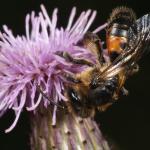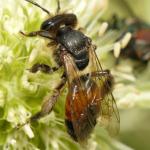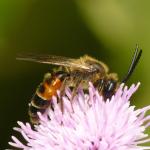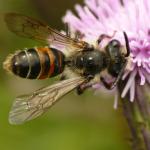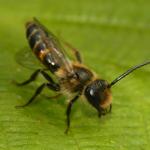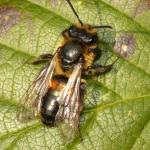Andrena zonalis KIRBY 1802; Andrena eximia possible misidentification (see below)
Until recently Andrena rosae was described as having a spring and summer brood, these forms being known by the names eximia Smith 1847 and rosae Panzer 1801 respectively. However, recent authors (e.g. Westrich 1989; Schwarz et al. 1996; Gusenleitner & Schwarz 2002) have referred to these broods as two distinct species, with the name eximia being treated as a junior synonym of stragulata Illiger 1806. A main reason for this involves the considerable morphological differences in the form of the head in the males. That of stragulata has a strong, prominent, ventrally-directed genal spine (adjacent to the base of the mandible), whereas rosae lacks this feature. There is, however, a male rosae in the BMNH which was collected at Newton Abbott in August 1927 and which has such a spine. Historically both these bees seem to have been nationally scarce species. Both rosae and stragulata (in particular) have their gasters conspicuously marked with red, resembling other red-marked Andrena, such as bimaculata (summer brood), florea and trimmerana (summer brood).
Formerly widely distributed in southern England and south Wales. As with its close relative Andrena stragulata, many records are from Dartmoor, Devon. The species has been recorded once from Ireland, at Borris, Carlow, July 19th 1896, P E Freke (Stelfox 1927). Currently a very rare species in Britain, with recent records (1992-2005) from Cornwall, Devon and Kent. The distribution in mainland Europe of this bee is imperfectly known as literature records may refer to either rosae or stragulata. K Warncke (in Gusenleitner & Schwarz 2002) provides a distribution map for Europe in which both species are combined. In 1943, R C L Perkins collected thirty-one males and eight females (March 25th to May 2nd) of stragulata and twenty males and thirteen females (July 16th to August 28th) of rosae at Vale Down, Lydford (specimens in NHML).The presence of two closely related and very scarce bees in the same location and in the same year suggests there may be a closer relationship than that between two distinct species. Perhaps A. rosae does have two morphologically different broods? Unfortunately, owing to the rarity of both taxa, genetic investigation is likely to be very difficult, at least in Britain.
Although not previously considered to be at risk, the few recent records suggest a revised appraisal is required.
Not sufficiently known, though both coastal and inland habitats have been recorded.
Univoltine, mid July to early September.
Not known. Nests of this species have not been found in the British Isles.
Brambles (Rubus spp.), hogweed, sea-holly (Eryngium maritimum), wild angelica (Angelica sylvestris) and wild carrot (Daucus carota).
None have been reported.
2009


